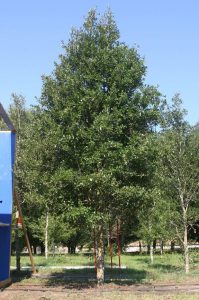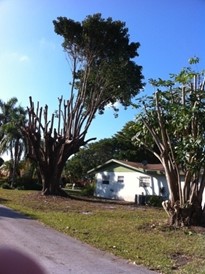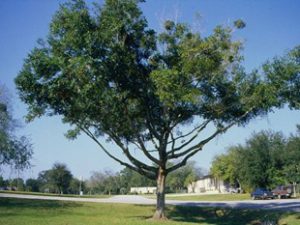Hurricane season started on June 1st. Are you sure your trees are in good shape? When was the last time you pruned them? How does the root system look? Do they have any broken or dead branches? How close the tree is to your own property? Usually, when we think of hurricanes, we think about our property or our homeowner insurance (mine increased by 40%!), but not much about the trees located near our houses. Trees could be an asset or a liability depending on the condition they are in. Some basic tips to improve your trees condition are:
- Never top or “hat-rack” a tree this is against the County Tree Code

Figure 1. Trees that are in the process to be hat-racked! It is illegal in Miami-Dade County, courtesy of H. Mayer.
- Trees with a thick canopy should be thinned, avoid removing more than 30% of the foliage per year. Most trees need to be pruned every 2-3 years. (Fig. 2 and Fig. 3)


- A tree with multiple trunks will become hazardous to people and property as they grow larger; it is better to have trees with one single trunk from top to bottom (Fig. 4 and Fig. 5)


- The roots and the trunk flare should not be damaged by weed eater equipment, construction debris or soil compaction.
- Buy good quality trees (Grade #1) that are adapted to south Florida soil and weather conditions.
- The best time to prune the trees is when they are young, it is cheaper, quicker, and more efficient.
- Choose trees that suit to the area they are grown in. Follow the “right tree in the right place” concept. Know the mature height and width of the tree! For small locations select small to medium size trees and for large places select big trees.
- Avoid planting trees near septic tanks, pools, sidewalks, driveways, utility lines and buildings (Fig. 6).

- Never cut a branch flush with the trunk, cut outside the branch collar and ridge (Fig. 7).

- Avoid “lion-tailing” (removing small branches and leaving the foliage only on the end) and “overlifting” (Fig. 8 removing all the lower branches).
-

Figure 8. Classic over-lifting, all lower branches were removed resulting in too much weight at the top of the canopy, courtesy H. Mayer. - Palms do not need hurricane pruning, they are adapted to windstorms.
Follow these easy guidelines and your trees will likely survive the hurricanes and give you plenty of benefits! (Fig. 9).

 1
1


